Quote for the week
“I Love LA”, Randy Newman (now there’s a name to conjure with) opening track from his album, Trouble in Paradise (now there’s a foretelling).
Los Angeles – city of the future past
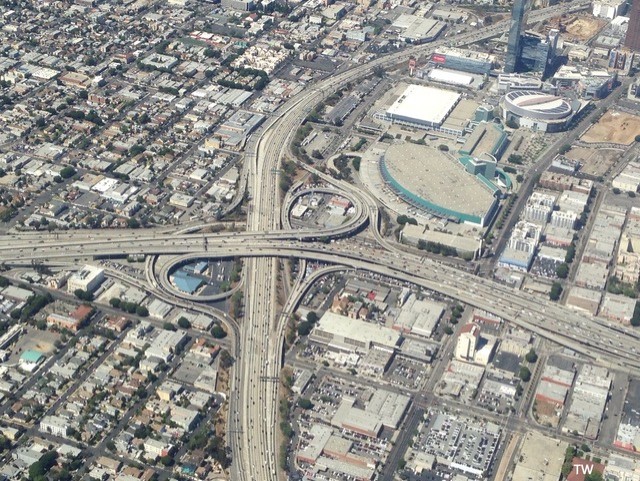
50 years ago, in the ‘year out’ between architecture degrees, most of my cohort went overland to London, following a path laid out just a couple of years earlier by Tony and Maureen Wheeler, which became the foundation of Lonely Planet.
I wanted to see the future for cities, not the past, and went the other way. Inspired by Reyner Banham’s recently published, Los Angeles: The City of the Four Ecologies, I headed to LA, landing in a newly minted Boeing 747 on the USA West Coast in April 1973, for six months study.
Banham saw LA as a city divided into different ‘ecologies’, which he called Surfurbia, Foothills, The Plains of Id, and Autopia. Banham’s exploration of the distinct architectural cultures of each ecology seemed to herald LA as the city of the future, despite, or perhaps because, it had only started in the twenties, got going in the thirties and forties (have you seen Jack Nicholson in Chinatown?) and really hit it’s straps post WW2.
The city was barely fifty years old when I set out with the recently published Banham under my arm. But already there were the individual jewels for which the city was architecturally famous: the Case Study Houses, modernist works by Eames, Wright, Schindler, Neutra, Ellwood, Drake, the Spanish revival courtyard houses, and so on.
The ‘ecologies’ spread out: along the beaches, in the canyons, and across the wide plains that had once been orange groves. But it was Banham’s fourth ecology, Autopia, that overwhelmed the others, not only the oversized freeways, but also the long, wide straight boulevards - Banham adored Wilshire as his raison-grid. And the cars, hulking beasts, sold in discount yards on La Cienega.
If you want to understand LA, you need to see it from a car (famously, Englishman Banham learnt to drive to understand the city). Out on the roads three things become apparent - the lasting legacy of LA: the freeways, the billboards and the smog. All part of Autopia. And those three things have barely changed.
Freeways
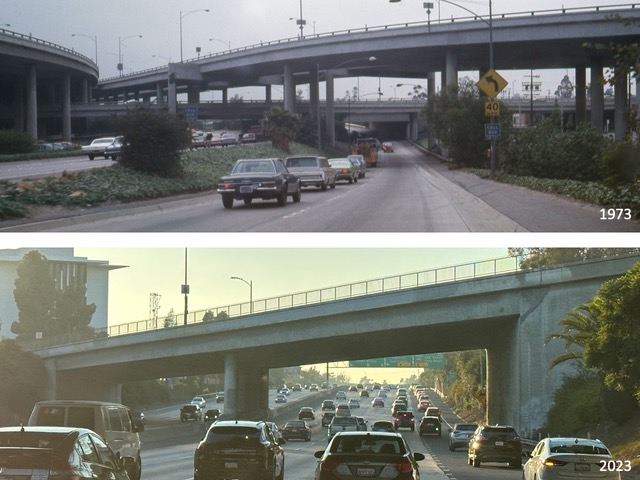
Like most big cities, LA is a series of individual villages, from the Beach Boys’ coast, to Joni Mitchell’s canyons, to South Central’s hip-hop, to the jazz of Downtown. But whereas NY, London, and Paris are held together with a Subway, a Tube, a Metro, LA missed the late 19th / early 20th C public transport, and went straight to the private car.
The interconnecting spaghetti of huge and vast freeways were well established by 1973. It was exciting to head out in the red Ford Fairlane 500, with a camera on the dash to capture the concrete columns and sweeping curves, as my mates from London’s AA and I went archi-prize hunting.
Most freeways were built high above the low-scale buildings with two results: they dominate the skyline as LA’s signature and, intriguingly by building up, the noise reverberates up and out, away from the houses; quieter than being built in a cut. Quieter yes, but never attractive. LA has rarely found a way to usefully occupy the spaces under its freeways, abandoned as wasteland, they are now colonised by the homeless.
50 years on? The freeways have not been substantially lengthened; far fewer built in the second fifty years as in the first, but many expanded, growing obese with extra lanes, and more cars. At peak times the speeds are said to be half what they were intended. Hence the first law of freeways: they are never big enough, too many cars will come. They are self-defeating.
Billboards
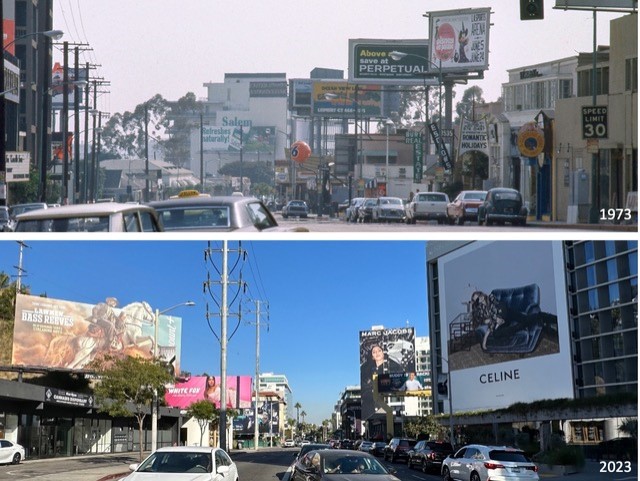
Second law of freeways: advertising signs increase in size relative to the speed of cars. LA pioneered giant billboards on freeways, that soon spread to Sunset and Hollywood, where they swamped the buildings. The signage was overpowering, rarely clever in the way Denise Scott Brown and Robert Venturi described in Learning from Las Vegas and Complexity and Contradiction in Architecture.
50 years on? Advertising still flourishes, and car culture still demands a quick read, so the billboards remain, despite the inroads of digital and social media. The freestanding ones are even bigger, to be seen from (supposedly) faster cars, and they’ve transmogrified to whole buildings. But the content remains the same: entertainment, entertainment, entertainment.
Smog
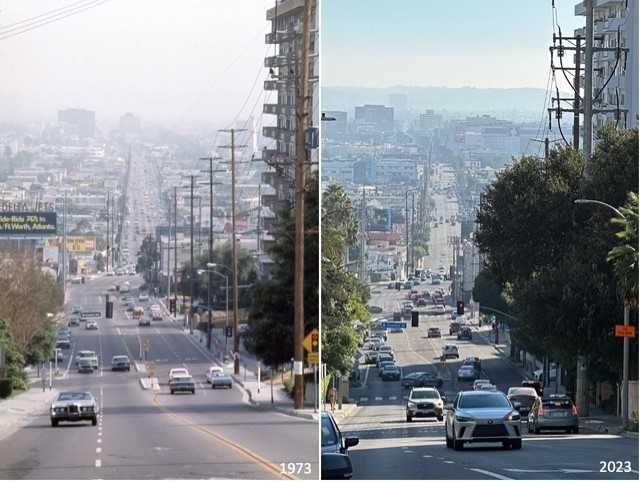
See the difference over 50 years in the view from Sunset looking down La Cienega (literally the swamp – a once accurate and appropriate naming). More cars, but you can see further as a result of the reduction in air pollution.
Which is the third law of freeways: they make pollution, lots of it. The roads are filled with broken parts and rubbish, and the air is filled with carbon, monoxide and dioxide. But air pollution has halved from 50 years ago, although the population of Los Angeles has doubled in that time. Two factors are at play.
California has led the USA in raising standards limiting emissions from vehicles, far in excess of those we have adopted in Australia. And LA, or at least Hawthorne, may be said to be the home, if not birthplace of Tesla. The electric car revolution is stronger in Southern California than anywhere else except Norway (where substantial incentives apply). Every second car on the freeways now seems to be a Musketeer.
A better appreciation of the vastness of LA results. Mulholland Drive gives a better grasp of the city as a whole; you see more from the Stahl House (Case Study 22); and Michael Connelly’s Hieronymus Bosch comes home from crime-solving to a spectacular view sparkling lights.
LA lessons
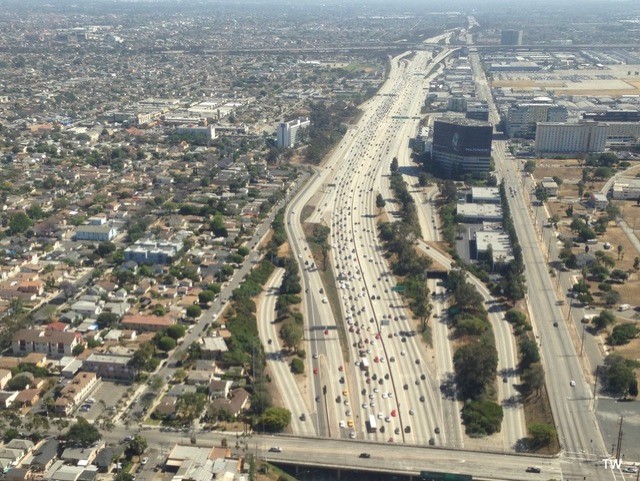
It’s no coincidence that Ridley Scott chose LA as the city of the future for Bladerunner in 1981. Equally, it is no coincidence that very little of the prognostications came true. LA doesn't feature flying cars, no matter how much Los Angelenos would like them, given the frustrations with the ever-dominant and ever-clogged freeways. Rather it is electric ones still finding it difficult to park.
LA is a city that looks like an airbrushed version of its original self from 50 years ago. Everything established at that time has continued, larger, bigger, more polished, and brighter. But beneath the glossy surface there is a social breakdown, particularly in inequality, highlighted in writings by Mike Davis.
It is this societal collapse that may well be the ugly portent. LA is indeed a city of the future, but a failing future, quite unlike the one I envisaged 50 years ago.
Bookends
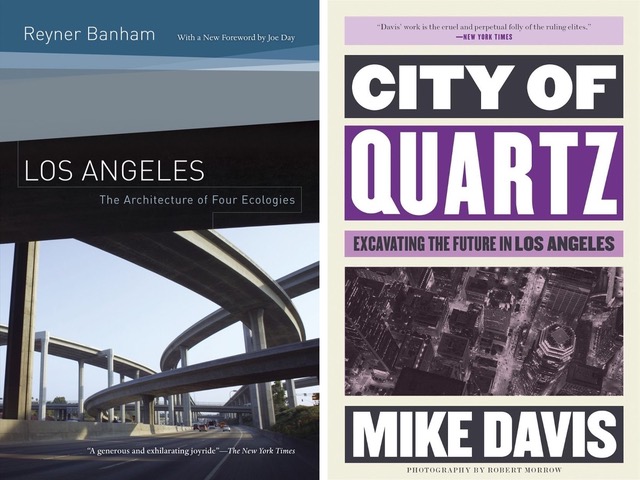
The two must-read books on Los Angeles: LA City of the Four Ecologies by Reyner Banham, originally published in 1971, this edition with an updated review of the ideas 35 years later; and City of Quartz: Excavating the Future in Los Angeles, by Mike Davis, originally published in October 1990, but now available in multiple soft cover versions.
Signs off
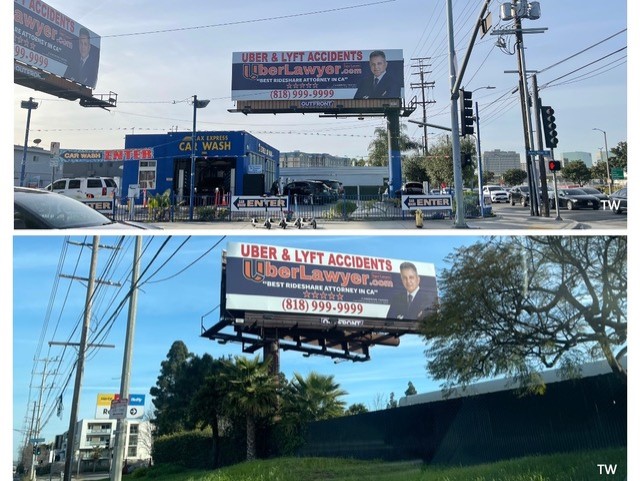
Signs of the times: the USA is litigation central so, as new technologies such as Uber and Lyft are developed, lawyers spring up to litigate the problems, hence the ‘Uber Lawyer’ (double entendre perhaps). Where better to advertise than on the streets where Uber and Lyft operate, not once, not twice but at least three times in the suburb of Arbor Vitae, Latin for living tree. More irony in your diet.
Next week
What are the lessons from LA that are not immediately apparent?
Tone Wheeler is an architect /adjunct prof UNSW / president AAA
The views expressed are his.
These Design Notes are Tone on Tuesday #187.
Past Tone on Tuesday columns can be found here
Past A&D Another Thing columns can be found here
You can contact TW at [email protected]

